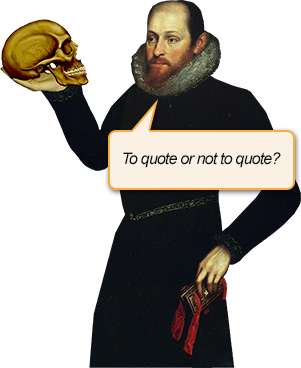Singin' in the Rain Quotes
Shmoop will make you a better lover...of quotes
ALL QUOTES POPULAR BROWSE BY AUTHOR BROWSE BY SOURCE BROWSE BY TOPIC BROWSE BY SUBJECTSource: Singin' in the Rain
Speaker: Don Lockwood
I'm singin' in the rain, just singin' in the rain.
Context
This line is from the song "Singin' in the Rain," sung by Don Lockwood (Gene Kelly) in the musical film Singin' in the Rain (1952).
Singin' in the Rain, set in the 1920s, is actually a movie about…making movies. Our hero, Don Lockwood (Gene Kelly), is a silent film star who used to be a stunt man. His leading lady, the loathsome, ditzy Lina Lamont (Jean Hagen), is easy on the eyes, but harsh on the ears.
This isn't a problem in silent films, but when movie studios start making "talking pictures," the golden duo of Lockwood and Lamont are in trouble. What to do when your leading lady sounds shrill, nasal, and just plain dumb? Enter Don's love interest, aspiring actress Kathy Selden (Debbie Reynolds), who's beautiful, kind, intelligent, and happens to have an amazing voice. Don, Kathy, and Don's best pal Cosmo (Donald O'Connor) pull an all-nighter trying to figure out how to solve the Lina problem, when they hit on the idea of having Kathy dub Lina's lines in the next film.
Don drops Kathy at home and gets a kiss goodnight. (Actually, good morning.) Relieved that their problem might be solved, and thrilled by his newly kindled romance with Kathy, Don gives up on his umbrella and sings and dances in the rain like the happiest man alive. His enthusiasm's so contagious, it makes you feel like dancing too.
Where you've heard it
The scene from "Singin' in the Rain" is wildly popular, and people do spin-offs of it all the time. Not only is it a great musical number, it's a great dance number, and Gene Kelly's performance is unbelievable. Plus, "I'm singin' in the rain" has become such a common phrase nowadays, that you might actually see people singing that in the rain.
What you might not know: Kelly performed that scene while he was sick with a high fever. Maybe he was delirious with happiness? Who knows, but it makes the whole scene even more amazing.
Additional Notable References:
- Oh, what a glorious scene it is.
- Check out a live performance of "Singin' in the Rain." Sorry, no Gene Kelly here.
- This song has appeared in dozens of films and television shows. Cary Grant's character, Roger Thornhill, whistles it in Alfred Hitchcock's North by Northwest.
- This song also makes a very disturbing appearance in Kubrick's violent classic film, A Clockwork Orange.
Pretentious Factor
If you were to drop this quote at a dinner party, would you get an in-unison "awww" or would everyone roll their eyes and never invite you back? Here it is, on a scale of 1-10.

It's never pretentious to sing a super happy song, and it's especially not pretentious to sing it in the rain. A little puddle splashing doesn't hurt, either.
